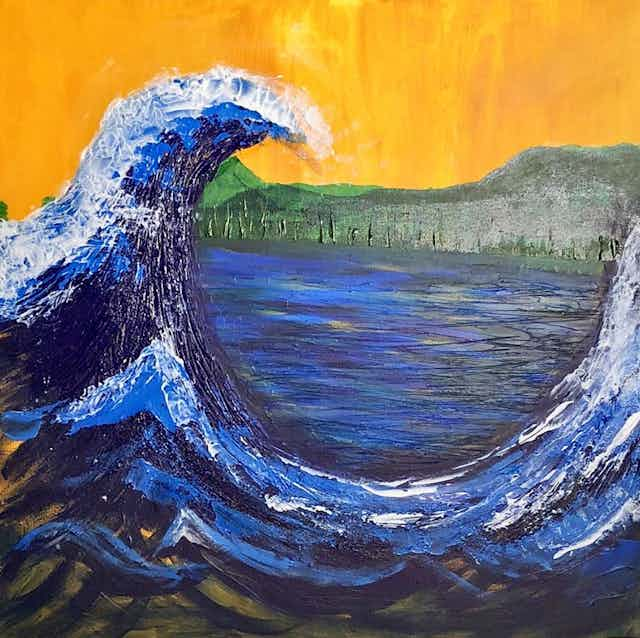Just How Trump Art Influences Public Understanding of Political Numbers
Just How Trump Art Influences Public Understanding of Political Numbers
Blog Article
Starting an Aesthetic Trip Via the Lyrical Analyses of Nature in Stylist Landscapes
In the world of art background, the Stylist activity stands out as an essential duration that changed the way nature was depicted on canvas. Artists such as Claude Monet, Camille Pissarro, Edgar Degas, Berthe Morisot, and Vincent Van Gogh captured the essence of the environment through their distinct interpretations, producing landscapes that go beyond mere visual representation. Each brushstroke, each play of light and shadow, and each color selection in their jobs speaks volumes concerning the artists' deep connection to nature and their ability to equate its elegance onto the canvas. As we discover the lyrical analyses of nature in Impressionist landscapes, we are invited to submerse ourselves in a world where fact and feeling link, providing a look right into the artists' profound admiration for the environment.
The Exciting Brushstrokes of Claude Monet
Claude Monet's proficiency of brushstrokes transcends plain strategy, imbuing his landscapes with an aerial quality that mesmerizes and mesmerizes audiences - trump art. His ingenious use shade and light, incorporated with his distinctive brushwork, develops a feeling of activity and life within his paints. Monet's popular series of works illustrating water lilies and his famous haystacks display his capability to catch the fleeting impacts of light and ambience

Enjoying Light and Darkness With Camille Pissarro
Symbolizing a comparable respect for the interaction of light and darkness, Camille Pissarro's imaginative vision unfolds as an unified exploration of the environment's luminous nuances. Pissarro, a key figure in the Impressionist activity, masterfully caught the dynamic partnership between light and darkness in his landscapes. His proficient use of color and brushwork enabled him to communicate the refined changes in light that define various times of day and periods.
Pissarro's paints typically include spotted sunlight infiltrating leaves, casting intricate patterns of light and shadow on the planet below. In jobs such as "Hoar Frost, the Effect of Snow, Pontoise," Pissarro skillfully portrays the crisp brightness of winter season sunshine compared with the great shadows that specify the snowy landscape. By welcoming both light and darkness in his structures, Pissarro invites visitors to immerse themselves in the natural elegance and short-term effects of light worldwide around them.

Via Pissarro's works, we are advised of the transformative power of light and shadow, welcoming us to pause and appreciate the fleeting moments of appeal existing in the daily landscapes that surround us.
A Symphony of Color Styles by Edgar Degas
Edgar Degas orchestrates a vivid harmony of colors in his masterful art work, infusing Homepage his make-ups with a vibrant interplay of colors check my blog that captivate the visitor's stare. Recognized primarily for his ballet dancers and intimate scenes of Parisian life, Degas adeptly controlled colors to share state of mind and movement in his paints. trump art. His use of bold, contrasting shades and subtle tonal variants produced a feeling of depth and vibrancy within his works
Degas' color combination often contained abundant blues, deep greens, and warm oranges, which he used with certain brushstrokes to capture the significance of his topics. Whether representing a ballerina mid-performance or a group of friends conversing at a cafe, Degas' shades not just depicted the scene however also stimulated a sense of emotion and energy.
In Addition, Degas' experimentation with light and shadow added an added layer of intricacy to his shade structures, boosting the total atmosphere of his paints (trump art). With his skilled adjustment of color, Degas created an aesthetic symphony that continues to reverberate with viewers today
Exploring Nature's Tranquility With Berthe Morisot
Berthe Morisot's imaginative vision uses a peaceful separation from the lively shade harmonies of Edgar Degas, as she catches the serenity of nature in her evocative landscapes. Understood for her fragile brushwork and intimate portrayals of everyday life, Morisot's landscapes emanate a sense of peace and consistency.
Morisot's paintings frequently feature soft, muted tones that communicate a sense of peace and tranquility. Her jobs, such as "The Cradle" and "Summer's Day," showcase her ability to catch the refined beauty of nature in a manner that is both calming and reflective to the audience.
Unlike several of her Stylist counterparts who focused on vibrant colors and dynamic make-ups, Morisot chose to produce mild, reflective scenes that invite the audience to stop and mirror. Via her skillful use light and darkness, Morisot creates a sense of peace that reverberates with the customer on a deep psychological level.
The Emotional Landscapes of Vincent Van Gogh
Vincent Van Gogh's landscapes vividly share a deepness of feeling with their vibrant brushwork and meaningful use shade. The Dutch post-impressionist musician is renowned for his capacity to record extreme and raw feelings in his paints, going beyond standard representations of nature. Van Gogh's tumultuous personal life, marked by mental health battles, substantially influenced his art, instilling his landscapes with a feeling of unease, sorrowful, or exuberance.
In jobs such as "Starry Evening" and "Wheatfield with Crows," Van Gogh's swirling brushstrokes and vibrant shade options evoke a profound emotional reaction from customers. The rough skies and agitated landscapes in his paints show his inner chaos and psychological disturbance, welcoming audiences to dive into the intricacies of his subconscious.
Van Gogh's distinct aesthetic language, defined by exaggerated viewpoints and vibrant usage of color, creates landscapes that reverberate with visitors on a deeply emotional level. Through his art, Van Gogh invites us to see nature not simply as an outside fact however as a mirror of our innermost sensations and feelings.
Conclusion
To conclude, the impressionist landscapes of artists such as Claude Monet, Camille Pissarro, Edgar Degas, Berthe Morisot, and Vincent Van Gogh provide a captivating and special visual interpretation of nature. Through their use brushstrokes, color, light, and emotion, these musicians have developed a symphony of photos that stimulate a feeling of calmness and charm in the natural world. Their jobs proceed to motivate and bewitch viewers with their lyrical analyses of the landscapes around us.
Each brushstroke, each play of light and shadow, and each color option in their jobs speaks quantities about the artists' deep link to nature and their capacity to translate its appeal onto the canvas. check out this site His ingenious use of shade and light, combined with his distinctive brushwork, produces a feeling of motion and life within his paints. His experienced usage of shade and brushwork allowed him to communicate the subtle shifts in light that specify different times of day and seasons.

Report this page